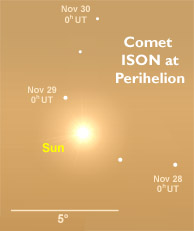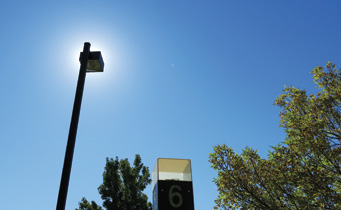Don't count on it — but if you'd like to try to detect the comet in broad daylight at perihelion, here's where and how.

If you want to try to spot Comet ISON in the daytime sky around the time of its perihelion, use this plot as a guide. Celestial north is up — you'll have to tilt the view to compensate for the time of day you're viewing (counterclockwise in the morning, clockwise in the afternoon for northern observers). Note that the Sun is only ½° across, considerably smaller than the impression in this plot. Click on the image for a larger view.
Sky & Telescope illustration / source: Stellarium
So far Comet ISON has spent November sinking ever lower in the east before sunrise as it heads toward the Sun. Ironically, the comet should brighten greatly as it disappears into the Sun's glare.
But you might have a long shot at seeing the comet at its very brightest, as it pulls a hairpin turn around the Sun on Thanksgiving Day, November 28th. Comet ISON will be physically closest to the Sun that day around 19h Universal Time (2 p.m. EST). It will appear within one Sun diameter of the Sun's edge from about 17h to 20h UT.
Use the chart at right to determine where the comet is with respect to the Sun. The comet's position is indicated every 12 hours (in Universal Time; adjust to your time zone accordingly), and celestial north is up.
As the chart shows, during its perihelion the comet swings around the Sun in a counterclockwise direction. It's due south of the Sun at 17:30 UT, very close to its southeast at 18:30 UT, due east at 19:20 UT, and farther northeast for several hours thereafter.

Block the Sun's disk very cautiously using a chimney or lamp post (pictured here) — not your wavering finger — on November 28th, and you just might glimpse the comet's fuzzy-pinpoint head with the unaided eye. Do not attempt this with binoculars or a telescope!
S&T: Alan MacRobert
From Comet ISON's point of view, the Sun will be enormous during its closest approach, filling the comet's sky and broiling its surface to a temperature of about 2,700° C (4,900° F). That's almost hot enough to melt iron, not to mention ice! The comet should peak in brightness from around perihelion until perhaps a few hours after.
Will it be detectable then? If you block out the Sun's disk very cautiously and carefully with no momentary lapses — put the Sun behind a chimney or lamp post, not your wavering finger — you might possibly detect the comet's fuzzy pinpoint of a head with the unaided eye if the air is very clear. Do not attempt this with binoculars or a telescope!
 17
17









Comments
Jim Baughman
November 22, 2013 at 5:32 pm
It sure would have been nice to see a GRAPHIC of ISON's movement around the Sun instead of a photo of a light pole blocking the day-time Sun. While I suppose I could figure out where ISON will be in relation to the Sun using the piecemeal location coordinates given, wouldn't an illustration have been a thousand times better? Please, S&T. Give us this article again sometime in the next week (time is running out...you have only six days) with a nice graphic showing what the Sun-ISON pairing will look like as the comet whizzes through perihelion on Thanksgiving.
You must be logged in to post a comment.
Thomas Miller
November 22, 2013 at 7:19 pm
I sketch the Sun every day that I can for about 2 years now.
I have seen a lot of space junk float by near and in front of the Sun
Has anyone seen a Comet through an Hydrogen Alpha Scope?
I have a Coronado 90mm Solar Max2 (Stacked) and a 140mm Vixen refractor with a 2" Baader Hershel ceramic wedge both mounted on an extended Explorer Scientific Twilight2 mount.
I'd read there is approx. 10 hour window in which ISON is with in 1 degree of the Suns surface (Both around and out of it's Sun orbit).
Being Thanksgiving I'd like help with Seattle area timing so I can get my grandkids involved with another thankful viewing.
Thanks for any Info
You must be logged in to post a comment.
KC
November 22, 2013 at 10:37 pm
Seems pretty darned unlikely you'd see a comet through an H-alpha scope. After all it is designed to block out even the sun's glare. Even if the comet reached -15 magnitude you wouldn't see it in the scope.
You must be logged in to post a comment.
KC
November 22, 2013 at 10:39 pm
PS Some of NASA's solar telescope however will be able to see it - see for example: http://www.isoncampaign.org/karl/updated-ison-encke-movie
You must be logged in to post a comment.
Oscar Sifuentes
November 23, 2013 at 9:34 am
Since I won't be able to see Comet ISON using my Coronado PST which has a H-alpha filter on it. Should I rather use my Bader Solar Film which I use to observe Sun Spots to see if I can spot the Comet? Or rather just find me a Light Pole or something to block the Sun like in the Photo above? Seams to work well.
You must be logged in to post a comment.
Kevin
November 23, 2013 at 9:55 am
By carefully securing the dark glass from a welder's mask to my binoculars, I got a very good look at the Venus transit! Of course, that was a black dot on an incredibly bright background, so it was very easy to locate. Nevertheless, I'll try the same method and try for a glimpse of ISON at perihelion.
Like all of us amateurs, I just hope it survives the pass and comes out intact! Also, nobody can predict what would happen if ISON pulled a "Shoemaker-Levy" surprise after the pass either. Just after ISON's discovery, it was so exciting to think about seeing it in daylight unaided. Most of us will be happy if it manages to hit -1 or better before it leaves our neighborhood.
You must be logged in to post a comment.
Brad
November 23, 2013 at 12:49 pm
To observe the comet, you cannot use any type of filtration that is normally designed to reduce the light of the Sun so that it is suitable for visual observation. That would also reduce the light of the comet by the same amount, and the comet will be no where near the brightness of the Sun. So, use some external object, such as the light pole shown here, to block the disk of the Sun. Then use normal white light (or maybe a red filter to darken the blue sky) and look for the comet. Using any optical aid could be dangerous if the Sun were to come out from behind your sun block.
You must be logged in to post a comment.
w
November 23, 2013 at 6:57 pm
Whoever is spraying tons and tons of metals, chemical and misc toxic matter above Ohio skies are making it impossible to see this comet in the wee pre dawn hours.. THANKS A LOT
You must be logged in to post a comment.
Sksur
November 25, 2013 at 7:44 am
The sun rises at 05.58 AM IST on 29.11.13 (00.28 UT)at Kolkata. Would it be worth trying to spot ISON just after that. (Would it be dangerous to direct my 10x50 binocular near the Sun even at that hour?)
You must be logged in to post a comment.
sksur
November 25, 2013 at 7:58 am
the sun rises at 05.58 am ist on 29.11.13 (00.28 ut)at kolkata. would it be worth trying to spot ison just after that. (would it be dangerous to direct my 10x50 binocular near the sun even at that hour?)
You must be logged in to post a comment.
Kevin Heider
November 25, 2013 at 9:09 am
Sksur, NEVER point your binoculars near the Sun. If you make a mistake you will instantly go blind in both eyes.
You must be logged in to post a comment.
Kevin Heider
November 25, 2013 at 9:09 am
Sksur, NEVER point your binoculars near the Sun. If you make a mistake you will instantly go blind in both eyes.
You must be logged in to post a comment.
T Miller
November 25, 2013 at 11:31 am
Looking directly into the sun (accidently) with any magnification is not a good idea. Your eye's can't react fast enough to avoid possible damage.
You must be logged in to post a comment.
Jim Baughman
November 25, 2013 at 2:31 pm
I would advise you to NEVER look anywhere near the Sun with binoculars. One accidental glance of the magnified Sun would burn a permanent hole in your retina. Is that worth it for a possible glimpse of a comet that you could wait a day or two to see much more easily?
You must be logged in to post a comment.
Alan Seeger
November 26, 2013 at 6:20 am
I would not suggest trying to find ISON with any kind of binoculars or telescope when it is this close to perihelion as the risk of inadvertently viewing the Sun's disk and sustaining retinal damage is simply too great. The only safe way to look that close to the Sun is with a solar filter, and then you would not be able to see the comet.
You must be logged in to post a comment.
Roland Boudry
November 26, 2013 at 4:51 pm
The melting point of iron = 1,538 °C = 2,800 °F = 1,811 K
You must be logged in to post a comment.
Jon Hanford
November 27, 2013 at 7:10 am
Universe Today has a post about observing ISON in daylight that includes several diagrams showing the position of the comet wrt the Sun: http://www.universetoday.com/106710/guide-to-safely-viewing-comet-ison-on-perihelion-day-novenber-28/
You must be logged in to post a comment.
You must be logged in to post a comment.